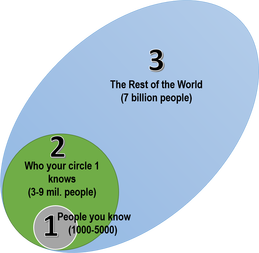The Three Circles of Your Network |
|

What Is It?
The Three Circles are a framework that allows you to break the world into three groups and to then tailor your message to those groups correctly. It gives you a set of market proven techniques for customizing your offer based upon which group the person belongs.
Why Should I Care About It?
Shared experiences with others can create trust and confidence that can be transferred to people you know in common. Your messaging can change based upon how much trust the other party has in you or your company. Once you have your messaging down for all three circles you can decide which type of customer acquisition process you want to run. You can pick your preferred customer.
Circle #1 – The People You Know
Most 25-year olds have easily met and had shared experiences with over 1000 people. By the time you reach 40 it can be greater than 5000. Social network sites such as LinkedIn maintain an inventory of your contacts and shared experiences. All these connections fall onto some arc that goes from a quick acquaintance to your closest confidant. Regardless, some amount of trust has been built and trust is the bridge to opportunity and growth.
What to do with Circle 1
How you communicate with people you know is more direct, you have a past to build off. When people you know hear of an offer from you, they often ask: CAN YOU DO IT? They already know that they can trust you. The key determinate is whether you have any competency. Your word and an example of past proficiency is typically enough. Circle 1 is about trust which is the good news because you have earned that. The bad news is that your first circle is not big enough to support a business.
Circle #2 – The Product of the People You Know and the People They Know
Circle 2 is about 3 to 9 million people. This very large number is tied into Metcalf’s law of Networks and it is amazing how big your second circle can become. People who know someone you know are a fantastic group of people to sell to and service with your commercial offerings. The important trust factor can be ported in through the common relationship and then they will often look for a public verification to proceed.
What to do with Circle 2
This group may ask: can you do it, and can you show me a few case studies and a website to review? Trust is still carrying the day and it is supported by competency and bona vides. The great thing about Circle 2 is that at 9 million people the 1% rule gives you a 90,000-person target pool, which is a real market.
The 1% rule states that no matter what you do, 1% of your network has a need for it now. When you are working with Circle 1 and you know 3000 people the 1% rule may hold, but it can’t keep you fed. Circle 2 and its pool of 90,000 will be more bountiful, but you must build a process to get your contacts to identify their contacts who need your services currently.
We cover this in our positioning your offering inside a social structure article. Circle 2 is about trust and verification. It is the perfect place for a professional service to exist.
Circle #3 - The rest of the world, all 7 billion of them
Companies and professionals today can have customers from all over the world who have never met anyone they know. The first shared experience is the business transaction. This customer is not going to trust you, they don’t know you. They are looking for a repeatable process and a brand that they can depend on. A brand is a promise wrapped up in an experience. Airline companies, auto manufacturers, and drug manufacturers exist on the power of their processes and their brands.
What to do with Circle 3
You can have success in this circle with a trademarked process and a mechanism for your happy customers to share openly about your re-mark-able offerings. As you have customers in Circle 3, look to bring them into Circle 1 and then turn their contacts into Circle 2 opportunities. These are the best kind of referrals as the reference point of trust is based upon the offering you shared with them. Circle 3 looks for process and brand. Deliver it and then pull their network into your Circle 2 processes.
Now What, How Does This Impact Me?
Look at your contacts and your offerings and consider running the following processes. Market your offerings to your 1’s in the context of the impending events that most correlate with people needing your service. Think weddings if you are a florist or photographer. Keep your marketing light and full of value to your 1’s, it leaves room for life in your friendships.
Build a communication medium and a cadence to share your insights and tools with your 1’s, such that they will then feel comfortable connecting you with the people they know who fit your target customers. You market to your 1’s the impending events that will allow them to tell you about the 2’s that you can then approach with your business offer.
The Three Circles of your Network gives the professional services company and its professionals a way to view the world of potential customers and a methodology for communicating with each group.
The Three Circles are a framework that allows you to break the world into three groups and to then tailor your message to those groups correctly. It gives you a set of market proven techniques for customizing your offer based upon which group the person belongs.
Why Should I Care About It?
Shared experiences with others can create trust and confidence that can be transferred to people you know in common. Your messaging can change based upon how much trust the other party has in you or your company. Once you have your messaging down for all three circles you can decide which type of customer acquisition process you want to run. You can pick your preferred customer.
Circle #1 – The People You Know
Most 25-year olds have easily met and had shared experiences with over 1000 people. By the time you reach 40 it can be greater than 5000. Social network sites such as LinkedIn maintain an inventory of your contacts and shared experiences. All these connections fall onto some arc that goes from a quick acquaintance to your closest confidant. Regardless, some amount of trust has been built and trust is the bridge to opportunity and growth.
What to do with Circle 1
How you communicate with people you know is more direct, you have a past to build off. When people you know hear of an offer from you, they often ask: CAN YOU DO IT? They already know that they can trust you. The key determinate is whether you have any competency. Your word and an example of past proficiency is typically enough. Circle 1 is about trust which is the good news because you have earned that. The bad news is that your first circle is not big enough to support a business.
Circle #2 – The Product of the People You Know and the People They Know
Circle 2 is about 3 to 9 million people. This very large number is tied into Metcalf’s law of Networks and it is amazing how big your second circle can become. People who know someone you know are a fantastic group of people to sell to and service with your commercial offerings. The important trust factor can be ported in through the common relationship and then they will often look for a public verification to proceed.
What to do with Circle 2
This group may ask: can you do it, and can you show me a few case studies and a website to review? Trust is still carrying the day and it is supported by competency and bona vides. The great thing about Circle 2 is that at 9 million people the 1% rule gives you a 90,000-person target pool, which is a real market.
The 1% rule states that no matter what you do, 1% of your network has a need for it now. When you are working with Circle 1 and you know 3000 people the 1% rule may hold, but it can’t keep you fed. Circle 2 and its pool of 90,000 will be more bountiful, but you must build a process to get your contacts to identify their contacts who need your services currently.
We cover this in our positioning your offering inside a social structure article. Circle 2 is about trust and verification. It is the perfect place for a professional service to exist.
Circle #3 - The rest of the world, all 7 billion of them
Companies and professionals today can have customers from all over the world who have never met anyone they know. The first shared experience is the business transaction. This customer is not going to trust you, they don’t know you. They are looking for a repeatable process and a brand that they can depend on. A brand is a promise wrapped up in an experience. Airline companies, auto manufacturers, and drug manufacturers exist on the power of their processes and their brands.
What to do with Circle 3
You can have success in this circle with a trademarked process and a mechanism for your happy customers to share openly about your re-mark-able offerings. As you have customers in Circle 3, look to bring them into Circle 1 and then turn their contacts into Circle 2 opportunities. These are the best kind of referrals as the reference point of trust is based upon the offering you shared with them. Circle 3 looks for process and brand. Deliver it and then pull their network into your Circle 2 processes.
Now What, How Does This Impact Me?
Look at your contacts and your offerings and consider running the following processes. Market your offerings to your 1’s in the context of the impending events that most correlate with people needing your service. Think weddings if you are a florist or photographer. Keep your marketing light and full of value to your 1’s, it leaves room for life in your friendships.
Build a communication medium and a cadence to share your insights and tools with your 1’s, such that they will then feel comfortable connecting you with the people they know who fit your target customers. You market to your 1’s the impending events that will allow them to tell you about the 2’s that you can then approach with your business offer.
The Three Circles of your Network gives the professional services company and its professionals a way to view the world of potential customers and a methodology for communicating with each group.
Vertical Divider
